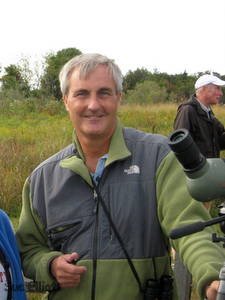I was presented Pete Dunne on Bird Watching, for review, by another Auduboner, who thought it was a good introductory book that, while slightly dated (2003), is still available and ought to be more well known.

Binoculars and spotting scopes are discussed at length in several chapters. Here must be everything you will ever need to know about the optics of lenses and the critical evaluations to consider when purchasing (porro vs. roof prisms, lens coatings, BAK-4 vs. BK-7 glass, optimal magnifications, etc.). The avid birder will be more confident when shopping for optical accessories. The beginning birder will be daunted by Dunne’s assessment that any binoculars with a tag less than $200 isn’t worth a second look.
Dunne follows with a detailed description of the maneuvers for correct use of binoculars, an acquired skill of frustrated beginners. He nearly envisions the experience birder as performing a choreography of mind-hand-binocular-bird intuitive flow of action for maximum identification success.
Although this is not a typical field guide akin to Sibley, Peterson, etc., Dunne does give a nod to their variable design, accuracy and illustration format. Here
a subsection covers process guides, “those guides that work best are those whose format is not so much anchored in a process as an embodiment of it.” This sounds to me, that if you’re well-versed in such apparently biblical field guides, you’ve mastered the Tao Te Ching of birding!
A chapter on where to bird mentions various local sites by habitat, noting that some of the best birding is upwind of sewage treatment plants, and gives extensive coverage of hotspots across the country and abroad, as well as pelagic (by sea) adventures.
Scattered throughout the book are inserts by guest writers with tips and anecdotes, such as one beginner’s expedition being matched with an (unknown to her) expert birder on a Christmas Bird Count.
Dunne is at his best when he comes down to reiterating his ten steps of bird identification, only the first few of which concern size, shape, and field marks. The more experienced birder then knows to consider behavior, flight patterns, ground and roosting activity, habitat, nearby birds, reaction to human presence, etc. He gives ample pages enlarging on these nuances.
Nonetheless, Dunne does seem to delight in propounding the proper ‘pishing’ pronunciation protocol, or enthralling with the near esoteric, as how to predict a fallout by watching the moon with your spotting scope on the night before you plan to go birding.
Fortunately, for the novice, such terms as “fallout” or “passerine,” glided by in the text, are defined by a glossary at the end of the book, where there is also an American Birding Association Checklist of the Birds of North America and a code of birding ethics.
This book is an omnibus of all things about birding outside of classic field guide identification. It will refine your skills and advance you toward your goal of expert birders. It is clear that the author finds himself a guru in that category.
The book is available at the Rutland Free Library and also at Amazon.com where it received a rating of four out of five stars.